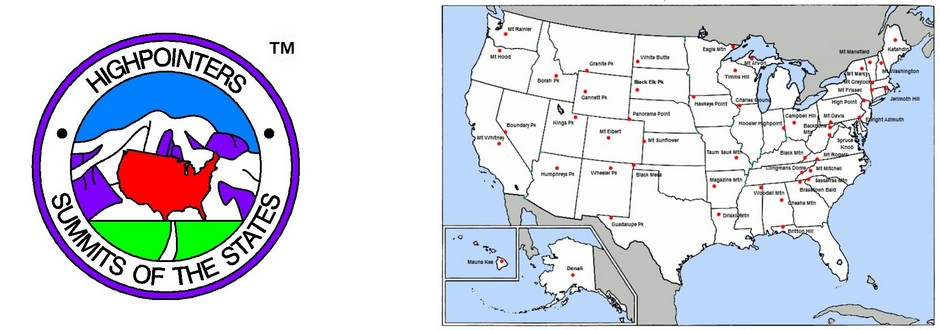 Highpointers attempted to climb Brooklyn’s highest point on April 29, 2006.
Highpointers attempted to climb Brooklyn’s highest point on April 29, 2006.
We had a wonderful brunch at South West New York on the banks of the Hudson River in the World Financial Center across from the the World Trade Center. However, believe it or not we got thwarted by a broken down subway, a massive antiwar demonstration and a slow moving waitress who kept us from visiting the Green-Wood Cemetery before closing.
Even in urban highpointing you need a “Plan B”!
Pictured above from left:
Laura Payeur (from Alaska), Don Berens (with his wife (unpictured) from Albany, New York; Michael Dickerson from East Hampton, New York; Sjaak van Schie from the Netherlands; Gary White from Alabama; Jean Trousdale (partially hidden) from Oklahoma; Ben and Steve Urbanski from Pennsylvania (one’s a nephew and the other’s an uncle); Charlie and Marilyn Zerphey from Pennsylvania; Diane Paxson and Bill Wentzel Diane Paxson from Pennsylvania. Read Bill Wentzel’s blog entry!
The New York Times had an article on NYC county highpoints strategic importance during the Revolutionary War.
This gave me a chance to plug the informal highpointers gathering on Saturday, April 29, when we visit the most strategic of the highpoints — the hill in Green-Wood Cemetery where the British nearly squashed the American Revolution by almost catching George Washington and his troops in 1776.
The lunch was at South West Restaurant on the banks of the Hudson in the World Financial Center across from Ground Zero at noon with a visit to the cemetery.
The NYT article follows historian David McCullough who visits the hill as part of the promotion for his current book 1776.
Here’s excerpts:
AT the crest of a hill in Green-Wood Cemetery in Brooklyn one day in early December, a gust of wind makes the just-below-freezing temperatures seem just above tolerable. A voice – three parts honey, two parts gravitas with a grain or two of gravel thrown in – rises to be heard above the wind. It is the voice of God, only friendlier.
“It was like the parting of the seas,” said David McCullough, the historian and familiar narrator of television epics, as we looked out on Brooklyn below and Manhattan in the distance.
He was recalling the retreat of Washington’s army across the East River on Aug. 29, 1776, a daring escape from advancing British forces. The harbor was filled with a huge force of British ships, but a strong wind kept them anchored, unable to sail upstream to engage the Americans. The Americans gathered small boats for the river crossing, and a fog allowed this makeshift armada to leave Long Island safely. “It was a miracle,” Mr. McCullough said. “If the wind had been blowing in a different direction that day, we’d all be sipping tea and singing ‘God Save the Queen.’ ”
At the cemetery, he led me to the statue of Minerva commemorating the Battle of Brooklyn, a horrific and demoralizing loss for the Americans, who had followed the British down to New York after brilliantly maneuvering them out of Boston. “Here and along the slopes of Greenwoods hills,” the inscription below Minerva reads, “our patriots for the first time faced their foe in open field; and we stood the test.”
Mr. McCullough is driven from book to book, he explained, closing his collar against the chill, by basic questions: “Who the hell are we? Where did we come from and how did we get to where we are today?”
He took my arm and walked me along a path at the top of the hill. Washington may have ridden his horse along this ridge, he said in hushed tones, taking in the woeful conditions of the makeshift American army and surveying the might of the 400 British ships in the harbor. “It must have been breathtaking.”
Jeffrey I. Richman, the historian of Green-Wood Cemetery, who was along on our walk, mentioned that John Greenwood (whose name bears no relation to the cemetery’s) was buried just down the hill, and Mr. McCullough had trouble containing himself. “This is so exciting!” he said, and was off with a gallop to the car to drive down for a look. (As it turned out, Greenwood became a dentist and eventually made false teeth for George Washington.) It is this kind of serendipity, Mr. McCullough said, a kind of magical realism full of small-world moments, that keeps him wading into the past.
New York Times Article
NY Times Walking Tour of Revolutionary Sites (including Bennett Park — the Manhattan highpoint where the walls of Washington’s last fort are still visible).


 Like us on Facebook
Like us on Facebook Follow us on Twitter
Follow us on Twitter Follow us on Instagram
Follow us on Instagram Watch us on Youtube
Watch us on Youtube Unofficial Highpointers Group
Unofficial Highpointers Group Americasroof Forum
Americasroof Forum





